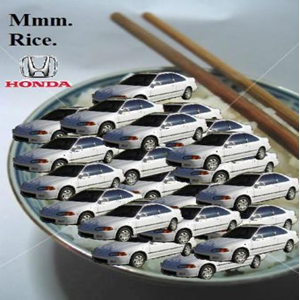There were two islands I am familiar of more than any other- Panay and Negros. And this is their tale:
Panay is an island of wide flats and small hills and on its flank stripped and strapped by many rivers. These natural irrigations made the place ideal for growing rice. Indeed rice was grown here ever since the first agricultural societies dwell in the island. The masses soon relied to rice. In fact they copied population spread from the fashion of the rice plant. Farmers which rooted from the mouths of the rivers speckled inwards, roads splits left and right, and split further left and right, and split further dividing to unpaved paths which end with isolated dwellings. Each dwelling is a watch over hut to a few rice paddies. The complexity of population distribution which was a gift during the agricultural period became a bad convention to serve with modernization. It rather made social cohesion, technology introduction, economic development and other government projects allocation difficult. It was in charge for the fall of the once progressive Panay.
Negros is island skirt to the Kanlaon volcano. The many years of eruptions fertile the soil enough to attract the elites of Panay to put up sugarcane plantations. The population which established here became dependent to sugarcane and imitated indeed the expansion of a sugarcane plant. The people rooting from a southern delta spread in northward and southward directions constructing compact settlements along the way like node ends in the sugarcane stalk. Each settlement is practically managed by a haciendero, a sugar baron, whose manor, sugar mill, and sugarcane workers, rest at the center of a vast sugarcane field. Each settlement is practically a society in itself. It became easier to build public facilities such as schools and implement economic developing projects in these packaged settlements. This condition made Negros advanced more rapidly than Panay in the modern era.
This tale might resonate as a fiction to you yet the whole lot of what was said here are real situations. Panay is an island in central Philippines intricately meshed into four provinces with a total of 90 towns but only 3 cities. Negros is the island just east of Panay but neatly divided into two provinces with a total of 38 towns and 19 cities. Negros is far advance then with city to town ratio of 1 is to 2. Way ahead of Panay ratio being 1 does to30. Practically, geography and population spread pattern became habitual causes of the continuous downfall of Panay while Negros soars.
I live in Panay and formulated this harsh comparison while having a trip to Negros last weekend: There are some habits we can not change. It sticks to us. It pulls us down. That is what I just discovered. I might regret publishing this in a self motivation blog but I simply have to mention my thoughts. Probably change might ensue breaking those habits. But I don not know how powerful it must be to fix the logarithmic damage brought by history. Probably what we have is acceptance and adaptation to it. Adaptation in a sense that to put this bad habit to good use instead of breaking it. I do not know how exactly. It is brain ruining to think about.







tank you for visited my blog...your blog more interesting
ReplyDeleteInteresting thing this one of internet. Nearly some days ago I get interested in some pages related to your archipelago, its history and so on, but always following the "official" or "milled" pathway.
ReplyDeleteEvery bit of field information is considered a treasure for me, because not always is easy to find. Blogs are genuine, otherwise they would have no purpose. So thank you for helping me in the search of authenticity.
History of Negros, hacienderos, and sugarcane plantations, has a lot to do with our ancestor's common past.
Regards
Cristóbal
Thank you very much. Gracias por visitar mi blog. El blog de usted me pareció también interesante. Congratulations!!!
ReplyDeleteHi, How is going. I am fine. And thank you, I must visit this space, because is very nice. Have interestings things, and aproachs.
ReplyDeleteAbout, Negro I don't understand if it is a city...because Negro it mean black in Portuguese, and have others means in english.
Thanks, have a good weekend
Already, I read very well about Negro, what mean, is Island.
ReplyDeleteSorry for first question, I made about Negro. Beacuse I didnt read ver good.
But other questions, there, in this Island living many blacks or no?
Hi thanks for visited my blog!!! you blog look very nice and more interesting.. but my english es very pour =(.. i dont understand so much =(
ReplyDeleteHello, thank you for your post ... I know you served for a little and read your experience in Panay ...
ReplyDeleteI am interested in knowing where it was, so I metí to Google Earth ... Be wonderful ... you live in a large island, I live in Santiago, Chile, but was born in the Argentine Patagonia and the whole area is known as "the world's ass" jajaja,
For a moment I dreamed to exchange our lives ... Your here and I there.
You command greetings and thanks for me
您好,感谢您对邮政...我知道你的服务一点,并宣读了,你的经验在班乃...
ReplyDelete我有兴趣知道那里有人,所以我metí给Google地球...美妙的...你住在一个大岛,我住在智利圣地亚哥举行的,但出生在阿根廷巴塔哥尼亚和整个地区被称为"世界上的驴" jajaja ,
一个时刻,我梦见交换我们的生命...你在这里,我有。
你指挥的问候和感谢,我
Hi!
ReplyDeleteIn the name of "Solo Solteritos Club" I thank you for the visit
I hope you had fun in our blog!
(And sorry my english :P)
Bye ^^
Hi there!
ReplyDeleteThanks for visit my blog.
You've got a very interesting blog...
I will return to visit quietly.
See you
A great article, thanks for sharing, this is basically an essay, very valuable insight, congratulations amigo, I enjoyed it.
ReplyDelete